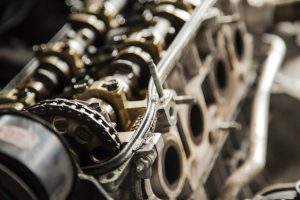3D printing is enhancing prototyping, production and maintenance in turbomachinery manufacturing.
The technology offers a good alternative to casting and machining for a wide range of turbomachinery components.
In this week’s Application Spotlight, we explore the benefits of 3D printing in turbomachinery manufacturing, as well as look at some of the exciting examples of the technology in action.
Take a look at the other applications covered in this series:
3D Printing for Heat Exchangers
3D Printing for Bearings
3D Printing for Bike Manufacturing
3D Printing for Digital Dentistry & Clear Aligner Manufacturing
3D Printing for Medical Implants
3D-Printed Rockets and the Future of Spacecraft Manufacturing
3D Printing for Footwear Manufacturing
3D Printing for Electronic Components
3D Printing in the Rail Industry
3D-Printed Eyewear
3D Printing for End-Part Production
3D printing for Brackets
3D Printing for Turbine Parts
How 3D Printing Enables Better-Performing Hydraulic Components
How 3D Printing Supports Innovation in the Nuclear Power Industry
What is a turbomachine?
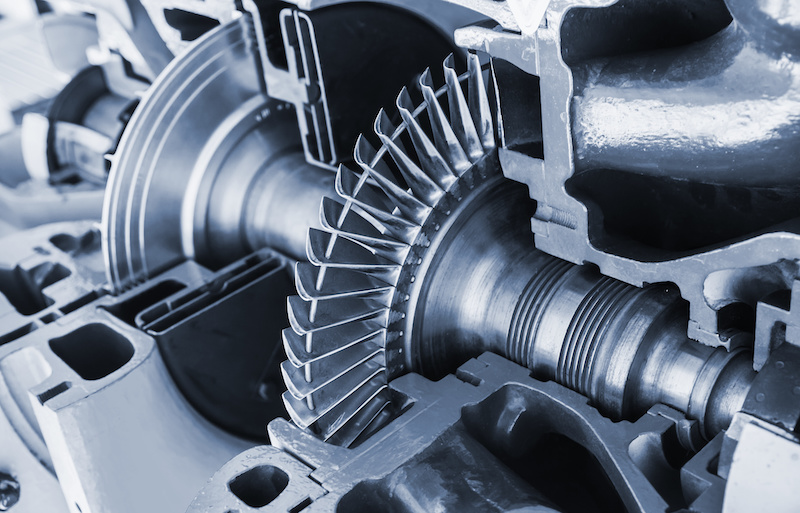
The benefits of 3D printing for turbomachinery
Turbomachinery components – such as impellers, swirlers, burners, pumps and compressors – are used in a very high load and temperature environment, meaning that they must excel in strength and durability.
In the majority of cases, turbomachine components are produced in the casting process, whereby molten metal is poured into a mould, shaped as a part. This process tends to be very labour intensive and time-consuming, not least because of the long lead time for designing and manufacturing of tooling.
Furthermore, the turbomachinery manufacturing sector is gradually transitioning to a new energy economy, with stringent requirements to improve the efficiency and lower the emission of turbo engines used at power plants and in aircraft.
As a result, companies involved in turbomachinery manufacturing started to explore new manufacturing methods, including 3D printing, to tackle these issues and produce better-performing and more sustainable turbomachinery components.
So here are the key benefits of producing turbomachine parts with 3D printing:
Faster product development
Faster production
The production of turbomachinery components can also be accelerated with the help of 3D printing. A case in point is a fluid engineering company, Sulzer, which combined metal 3D printing and machining into a hybrid process to produce closed impellers.
An impeller is the rotating component of a pump. It transfers the energy from the motor to the fluid and accelerates the fluid to build up pressure. In contrast to an open impeller, a closed impeller, additionally, has a front shroud attached to it.
Traditionally, this component is cast. However, the casting process, in this case, bears the risks of producing impellers with small internal and surface defects, limited surface quality and a lead time of up to thirty-five days.
To speed up the process, Sulzer came up with a hybrid approach, in which additive and subtractive manufacturing are combined in one machine tool.
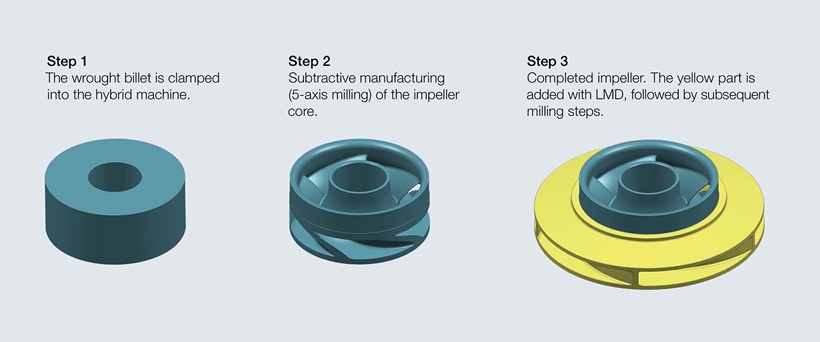
Sulzer’s hybrid process for manufacturing closed impeller [Image credit: Sulzer]
The process for a closed impeller starts with a small wrought billet, which is machined to its final geometry with 5-axis milling operations. When the impeller core is finished, the remaining geometry for the final impeller is radially built up with the help of Laser Metal Deposition (LMD) process. In this process, the metal powder is pushed through a feed nozzle where it is melted by a focused laser and successively added onto the build platform.
Sulzer states that this approach will ultimately enable it to produce a closed impeller in around forty-eight hours, which is a radical drop in time compared to the casting process.
Design flexibility
One of the biggest advantages of 3D printing for turbomachinery is the ability to innovate the design of components. An example of this is part consolidation, when a component made of several pieces is designed as a single part. This design practice helps to reduce assembly time and also improves the strength and durability of the component.
Siemens has illustrated this benefit by redesigning a gas turbine fuel swirler with the help of 3D printing. The swirler is a part responsible for mixing air and fuel prior to combustion by the burner.
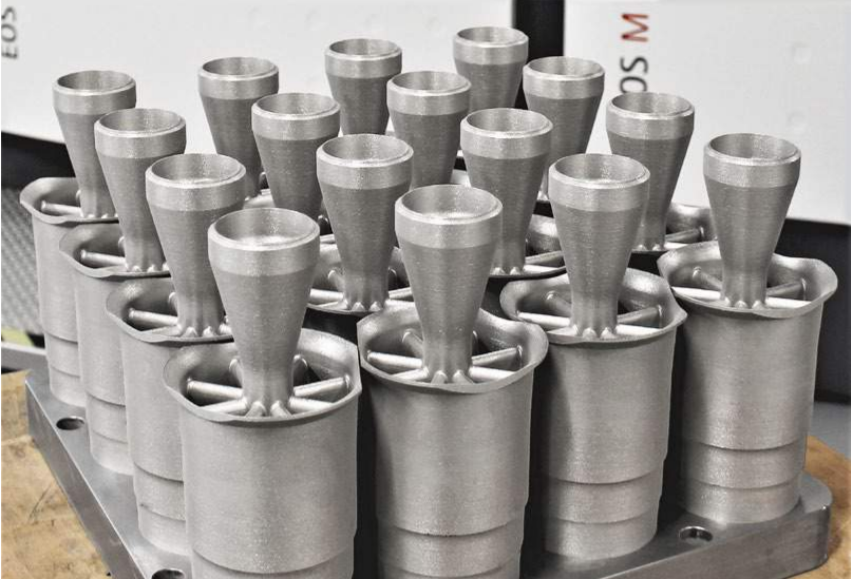
16 swirlers can be 3D printed simultaneously on a single 3D printer [Image credit: Siemens]
Conventionally, the swirler is made up of ten cast and machined parts welded together. Machining and welding steps typically account for about six hours of processing time per swirler for the conventional design, not including the time for casting.
Driven by the possibility to reduce manufacturing time, Siemens redesigned the swirler assembly by integrating vanes, a shroud, and mounts into a single additive manufacturing (AM) design. To meet the high-temperature demands of the application, the swirlers are made in a proprietary, solution-strengthened Inconel alloy.
Currently, the company can print 16 swirlers at one time on EOS M 400-4 quad-laser Powder Bed Fusion systems, with a full build taking up to a hundred hours.
The successful application of 3D printing in the production of turbine components leaves Siemens positive that the technology will be instrumental in developing even more powerful, environmentally friendly and durable gas turbines and components in the future.
Quicker repair
Another benefit of 3D printing is the ability to repair worn-out components faster than with traditional repair methods. Selective Laser Melting (SLM) and LMD are the two technologies that can be used to repair parts.
In addition to 3D printing turbomachine parts, Siemens has also developed a way to repair damaged components. An example of the process is the burner tip repair procedure. The tip of the burner is exposed to hot gas and heat radiation within the combustion chamber, meaning that it wears out quickly and needs to be replaced. Siemens was able to develop a customised SLM machine, establishing a faster and more economical repair procedure.
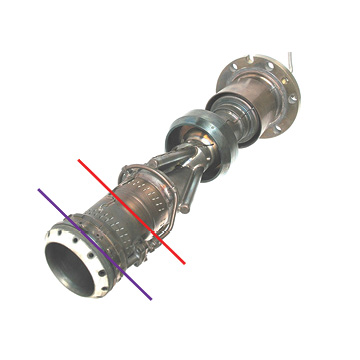
Gas turbine burner repair requires much smaller replacements when using SLM purple line compared to conventional cut and welding red line [Image credit: Siemens]
The key benefit of using 3D printing has been that SLM repair required a much smaller area of the burner tip to be removed and replaced (see image).
Once the damaged area is cut off, the entire burner is then placed in the SLM system, where a camera identifies the exact 3D position of the burner tip face and projects a CAD model on it. Then, a new tip is built up layer by layer.
According to Siemens, this approach lets it reduce repair time by 90 per cent. Since the introduction of SLM for repair in 2013, Siemens has repaired more than 2000 burners.
In addition to SLM, Siemens has also qualified the LMD process, which is used to repair blades and vanes, thus replacing conventional welding technologies.
3D printing – the future of turbomachinery?

A turbine blade featuring 3D-printed rectangle sensors [Image credit: Optomec]
Furthermore, GE, the Oak Ridge National Laboratory and Xerox-owned PARC have recently been granted over $1.3 million to reduce the timeline for designing and validating 3D-printed turbine components by as much as 65 per cent.
By pushing the boundaries of the technology, the team aims to deliver a defect-free, high-performance 3D-printed multi-functional design that is able to withstand high temperatures and stresses.
Clearly, the use of 3D printing for turbomachinery parts is only beginning to get traction, yet it shows no signs of slowing down. Going forward, more and more manufacturers will be driven to adopt the technology to be able to design and produce more durable, efficient turbomachinery products.

![Read more about the article 10 of the Biggest Challenges in Scaling Additive Manufacturing for Production in 2020 [Expert Roundup]](https://global3dhub.com/wp-content/uploads/2021/01/10-challenges-in-scaling-additive-manufacturing-for-production-820x461-1-300x169.png)
